Summary of Gran Fury
Gran Fury was a New York-based art collective that used their savviness in media, art, and design to create public artworks that responded to the AIDS crisis. Working in tandem with the AIDS Coalition to Unleash Power (ACT UP), the group channeled their anger at government inaction and homophobia into powerful, oftentimes confrontational images that aimed to educate the public on HIV/AIDS and provide a catalyst for social and policy changes.
Accomplishments
- Gran Fury's work provided a coherent visual identity for ACT UP, supporting the group's activity and intervention in the public sphere. Their work is a strong example of protest and political art that led to tangible results beyond the art world.
- Gran Fury turned inexpensive and homegrown techniques, such as pasting flyers with wheat adhesive, into a powerful political tool. With simple yet striking visuals and guerilla dissemination tactics, they were able to leverage their limited resources to cut through the saturated visual landscape of New York and get their point across.
- In the face of homophobia, discrimination, and hate-mongering, Gran Fury stood firm in proudly displaying queer desire. They were some of the most successful activist groups in history to provide such groundbreaking, and public, visibility to queer lives.
- In the context of the 1980s New York art world awash in postmodern theory and intellectual discussions about linguistic signs in art circles, Gran Fury's work showed that it was possible to marry theory and practice with an activist spirit.
The Life of Gran Fury
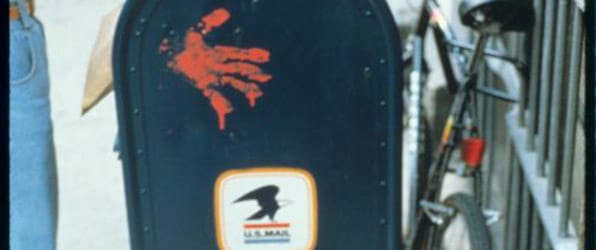
Less concerned with art discourse than direct action, Gran Fury used their art world connections to access funding and public spaces, but made work aimed squarely at the general public.
Important Art by Gran Fury
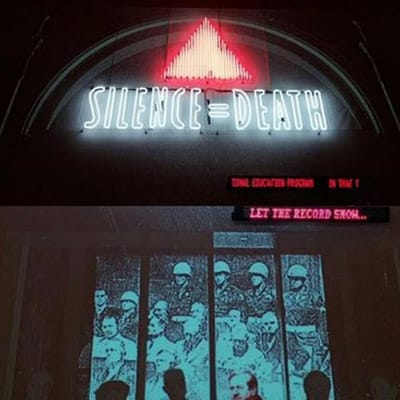
Let the Record Show
Let the Record Show was Gran Fury's first work. It was an installation in the window of the New Museum on Manhattan's Lower East Side. The work brought to light prejudiced attitudes of a number of public figures. It consisted of multiple elements, interacting to create a damning commentary on the handling of the AIDS crisis thus far. The backdrop was made of photographs of the Nuremberg trials, held after the Second World War to prosecute war criminals. In front of this were six cardboard cutouts, a selection of "criminals" of the crisis: President Ronald Reagan, US Senator Jesse Helms, televangelist Jerry Falwell, conservative columnist William F. Buckley Jr., Cory Servaas of the Presidential AIDS Commission, and an anonymous surgeon. Beneath each cutout was a concrete slab, into which was carved a quote from each figure that revealed their attitudes. For example, inscribed underneath Falwell were his words "AIDS is God's judgment of a society that does not live by his rule." Hovering above the window was Finkelstein's chilling logo, reminding us that "Silence = Death," with the pink triangle a reference to the badge that the Nazis had used to identify gay men and transgender women in concentration camps (In contrast to Finkelstein's design, the Nazi triangle was downward pointing).
In many ways, this early work was hectic, including perhaps too many elements. In fact, member Marlene McCarty later described it as "a mess." It is worth noting however that it articulated the AIDS crisis in a way that would become typical of Gran Fury's work: it utilized pre-existing imagery, catchy or snappy graphic visuals, cutting text, and a direct engagement with politicians and public figures. In terms of its social message, as art historian Richard Meyer notes, it "locates the root cause of the AIDS crisis not in HIV infection but in larger social forces and constituencies."
The location of the work meant that it would have been seen by passers-by, not only people visiting the museum. And the design of the display may have struck viewers as closer to a department store or history museum display than a contemporary work of art, reducing the "fine art" cultural barrier. Both the opportunity for public viewing and the accessibility of the work's meaning were key to the group's communication strategy.
Mixed media window installation (photo collage, neon lighting, cement blocks, cardboard cutouts)
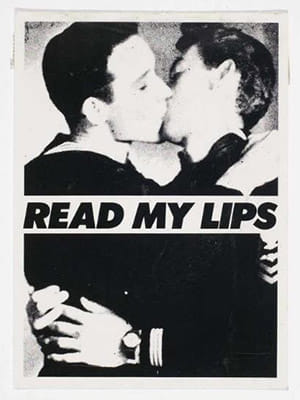
Read My Lips
The Read My Lips posters were part of a series of graphic design work advertising various protest events during "Nine Days of Rage," which took place in the spring of 1988. This particular piece was designed to advertise a "kiss-in" in Sheridan Square in Manhattan, and shows two American sailors, embracing and kissing, in front of which runs the slogan "Read My Lips."
A kiss-in derived from sit-in protests tracing back to the Civil Rights Movement (a sit-in is a form of civil disobedience in which a protester sits in a certain seat and refuses to move. Black activists used sit-ins to demonstrate against segregation by occupying areas such as white-only seats at a lunch counter). In a kiss-in, participants, especially same-sex couples, gathered and kissed in defiance of the conservative attack on homosexuality. As well as advertising the protest event, this work had the function of bringing same-sex desire into the public sphere beyond the protest. It asserted that gay and lesbian couples have equal rights to public space, without fear of discrimination or abuse. By using a photograph from World War II of two sailors kissing, furthermore, the work located contemporary homoeroticism within a long history of queer culture and queer self-representation. The figure of the sailor is especially significant in the history of queer culture and art, with a key example being the work of pioneering gay painter Paul Cadmus, who depicted gay sailors in the 1930s.
A symbol of pride and defiance, Read My Lips became one of Gran Fury's most successful designs. Simple, memorable, and to the point, it was a common sight at ACT UP protests and rallies in the coming years, appearing on signs, t-shirts, and badges.
Newsprint Poster / Paper Flyer
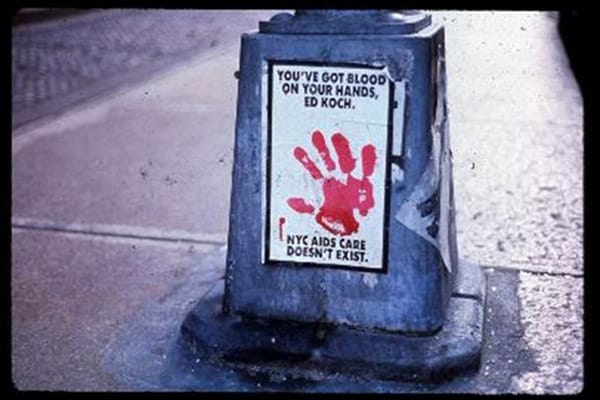
The Government Has Blood on Its Hands
A bright red hand print draws our attention to the poster, with the declaration: "You've got blood on your hands, Ed Koch. NYC AIDS care doesn't exist." This work was part of a poster series, each featuring a bright red hand print and a different text. Richard Meyer notes the significance of the hand print, stating that it represented "a trace of a body that is no longer present, presumably because it has died from government neglect." The series literalized the expression "blood on one's hands" and was part of the group's effort to shame public figures and bring about accountability. In this instance, the poster directly named then-mayor Ed Koch and suggested that people were dying as a direct result of his actions (or, perhaps more accurately, his inaction). To increase the impact of these posters, members of Gran Fury would dip their own hands in red paint, and mark their handprints all over the streets near where the posters were posted, such as on mailboxes, street signs, kiosks, and so on. Richard Meyer writes that "this strategy set up a call-and-response between the painted handprints and the printed poster: the poster's message clarified the meaning of the red handprints even as the handprints dramatized the anger and immediacy of the poster."
By taking artworks into the streets, Gran Fury aligned their practice with the writing of Douglas Crimp, an art historian and key figure in AIDS cultural analysis then, who stated that "we don't need a cultural renaissance; we need cultural practices actively participating in the struggle against AIDS. We don't need to transcend the epidemic; we need to end it."
Newsprint poster, red paint

Kissing Doesn't Kill
One of Gran Fury's most well-known and controversial pieces of public art was their Kissing Doesn't Kill; Greed and Indifference Do graphic, created in 1989. The work was produced as a public art campaign, to be featured on public transport around the cities of San Francisco, Washington, D.C., and Chicago. It drew heavily on the visual language of contemporary advertising, in particular, the widely recognized aesthetic of United Colors of Benetton ad campaigns, with their empty background, vibrant colors, and racially diverse models intended to celebrate multiculturalism. Gran Fury's design features three bi-racial couples kissing, two of whom appear to be the same gender. Originally the piece was intended to also include the tag line "Corporate Greed, Government Inaction, and Public Indifference Make AIDS a Political Crisis," but these words had to be removed due to corporate pressure from financial sponsors.
Although the more political wording was lost, the piece was effective in opening up conversation around gay desire and eroticism, and changing public perception of homosexual relationships. At the time, a common misconception around AIDS was that it could be transmitted via saliva, and so kissing was seen as a dangerous act. Rejecting such misinformation was seen to be part of the wider work of reducing stigma around AIDS in the public. Richard Meyer notes that this work "mimics the codes of capitalist pleasure and visual seduction to capture the viewer's attention and direct it to the AIDS crisis," referring to how the advertising industry uses images of (mostly heterosexual) sex and desire to sell products. The work was initially banned in Chicago, due to objections by state senators over the display of same-sex couples kissing. When it was finally displayed, it was subjected to vandalism by members of the public. Despite this, Gran Fury succeeded in bringing gay desire into general discourse in an unprecedented manner, with the banners being discussed across multiple news outlets throughout America, not to mention on the floor of the Illinois State Senate.
Billboard poster
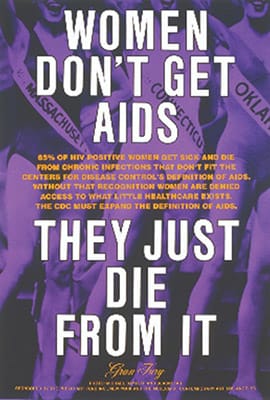
Women Don't Get Aids They Just Die From It
This poster was placed in 83 bus shelters across Los Angeles in 1991. In bright, white text it reads "Women Don't Get AIDS. They Just Die From It." This puzzling contradiction is explained further in the smaller, orange text stating that the Centers for Disease Control's definition of AIDS led to the undercounting of women with HIV, which impacted their access to healthcare as well as the allocation of medical resources. Behind the text is a purple-tinged background showing three women lined up in a beauty pageant, their faces cropped off above their standardized smiles, their bodies posed in mimicry of one another.
This work utilizes the advertising tactic of posing a pithy riddle that catches the viewer's attention. Once the viewer took the time to digest its message, however, the structural barrier facing women seeking HIV care became clear. The background image of idealized "feminine" beauty, alongside the text, asks what the accepted image or role of women in American society is, and whether or not the reality of women's lives (including sex, illness, and death) can be accepted. The work also made an important point about how HIV affected all genders, despite the labeling of it as the gay plague" (exclusive to gay men) by conservative cultural commentators, as well as the implicit bias in the CDC's guidelines on it.
The graphic proved, overall, to be successful in communicating its message to the public, and was used regularly by ACT UP in their campaigns. (Eventually the CDC updated their definition). However, it should be noted that this particular work created tension within Gran Fury. While the women featured in the poster are white, the main audience for this poster were Los Angeles bus riders, who were likely to be working-class and majority brown or Black. When this issue was raised, some members insisted that race was irrelevant to the message. In response, Vazquez-Pacheco, a member of Puerto Rican descent and the collective's only member of color, quit the group.
Bus shelter poster
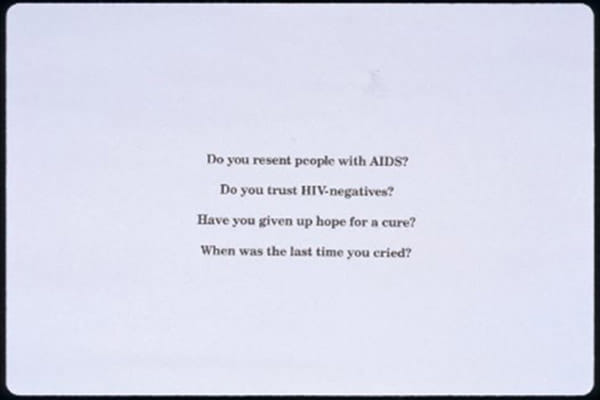
Four Questions
Four Questions was one of Gran Fury's final works, created before they disbanded in 1995. Unlike anything they had made before, this piece used no imagery whatsoever, and did not make any bold statements or damning accusations. Instead, it was a series of questions on a blank background: Do you resent people with AIDS? Do you trust HIV-negatives? Have you given up hope for a cure? When was the last time you cried?
Finkelstein stated that "this work was a response to our frustration at being unable to articulate the complexity of the issues. We decided to just go bare bones and say how we felt, which had never been our primary focus." After many long years fighting for medical care, acceptance, equality, accountability and so on, many activists were tired. And many if not all were grieving the loss of sometimes countless friends and allies. Meyer notes that "underlying the four questions ... is a larger question... How can we continue to fight an epidemic that, after all these years of anger and activism, still shows no signs of going away?" In these four questions, we see the sheer exhaustion pervading activist communities in the face of ongoing crisis.
Despite Gran Fury's success, the work serves as a melancholic reminder of the limits of activism and direct action in the face of larger social and political impasses. Formally, the simple text in black contrasting with the white background reads almost as elegiac, the poster's solemness contrasting with the exuberant fury of earlier works.
Newsprint poster
Biography of Gran Fury
Beginnings
From the first reports of AIDS-related deaths in the US (in Los Angeles in 1981) to the epidemic becoming a crisis, gay men were disproportionately impacted by HIV/AIDS. Lack of knowledge about this new disease then, as well as the stigmatization of individuals with HIV, all contributed to the crisis, but the biggest culprit was government ignorance and inaction (President Reagan did not mention AIDS publicly until four years into the epidemic). When government response came, it was also slow and ineffective. The situation led to a devastating death toll, as well as immense suffering and loss for the LGBTQ community. "Can you imagine what it must be like if you had lost 20 of your friends in the last 18 months?" asked AIDS activist and writer Larry Kramer in a 1983 interview. "No cause, no cure, people in hospitals. It's a very angry community," he added. Such anger, however, led affected communities to come together and form their own response.
Gran Fury arose organically along with the activist collective known as ACT UP, which came into existence in 1987 in response to the AIDS epidemic. ACT UP's primary aim was to organize direct political action to gain access to medical treatment for those with HIV/AIDS, and to increase education and research so as to eventually stop the spread of the disease.
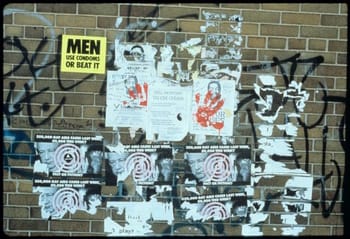
Group member Avram Finkelstein, who had lost his partner to AIDS, recalled how the group came about: "It was a time I felt very alone, so in late 1985 I co-founded a men's consciousness raising group with five friends. We met every week, loosely assembled around feminist organizing principles." A recurrent topic of conversation was the political dimension of the AIDS crisis, which led to the group's feeling that something had to be done to bring those affected together for collective action. In this regard they drew from precedents in political posters and visual activism from the 1960s. As curator Michael Cohen explains, "Gran Fury comes out of the hippie era, revolutionary committee meeting mentality." Finkelstein further reflected: "Because of my upbringing, the political poster had always played a role in my understanding of social change, but to be young in the late 1960s was to be political anyway. By 1968, the East and West Villages in New York were papered with manifestos, meetings announcements, and demonstration flyers. When young people needed to communicate with each other, we used the streets."
A poster that they put out in early 1987 led to an activist community that eventually became ACT UP, with members of the group that specialized in art and design forming Gran Fury. As an affinity group, their role was to spread the message of ACT UP, utilizing visual language that would be attention-grabbing and far-reaching. Gran Fury described themselves as a group "united in anger and dedicated to exploiting the power of art to end the AIDS crisis." They could in essence be understood as ACT UP's visual communications and public outreach wing.
Members of Gran Fury were part of a small circle of artists who, like Finkelstein, had grown up with examples of political art and activism in the late 1960s-1970s. They were all based in New York and drew energy partly from the East Village art scene, with its youthful and rebellious attitude. Segments of the New York art world then were receptive to queer art, such as the work of Robert Mapplethorpe and David Wojnarowicz. Like Gran Fury, Wojranowicz channeled anger about the AIDS crisis into his deeply personal art (both Mapplethorpe and Wojranowicz would die of AIDS). While Gran Fury's aim was primarily political, from the art side it was in this context of artistic experimentation and boundary-pushing regarding gender, sexuality, and politics that the group emerged.
Early Work
Initially, membership in Gran Fury was open to anyone who showed up at their meetings. Many people came and went. This method of co-creation worked up to a point, but eventually it was felt to be too difficult to take quick, decisive action in response to current events. From 1989 on, Gran Fury had a fixed membership, consisting of eleven main members: Richard Elovich, Avram Finkelstein, Amy Heard, Tom Kalin, John Lindell, Loring McAlpin, Marlene McCarty, Donald Moffett, Michael Nesline, Mark Simpson, Robert Vazquez-Pacheco. The name Gran Fury echoes the feelings of "grand fury" present within the gay community at the time. It also refers to the automobiles often used by the New York City police force, of whom AIDS activists were critical, due to their often abusive treatment of gay and lesbian citizens.
Gran Fury's first projects were often simple in scale and scope. Generally, people attending the meetings would bring along newspaper clipping or recount stories that related to the AIDS crisis. If the issue or story resonated with enough people, then an artistic response, such as a flyer or poster, would be created. As well, Gran Fury were also often enlisted to make content advertising events run by ACT UP, such as rallies and sit-ins.
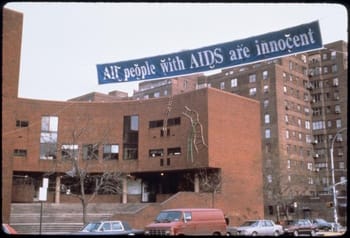
Their early works used simple, low-cost techniques such as guerilla postering campaigns around New York City using wheat-pasting (that is, using wheat-based adhesive) or the hanging of banners in public areas. These early campaigns drew more from the visual language and energy of political/activist visual culture than they did from fine art, and were in many ways necessitated by the group's limited funding. In these early years, the group generally refused to be interviewed, preferring to remain anonymous.. (In this they shared an approach with their contemporary, the anonymous Feminist art collective Guerrilla Girls, who were also active in New York).
Mature Work
From the start Gran Fury's strategy was to court the support of the art world for visibility, funding, as well as "access to public space." As their recognition grew, so did support from important figures and institutions in the art world. Gran Fury remained steadfast in their conviction, however, that their work be shown outside the gallery as much as possible. They were insistent that they were not producing work for an art audience, much less the art market. Instead, their work's primary aim was to spread information about AIDS and to hold society accountable for the crisis.
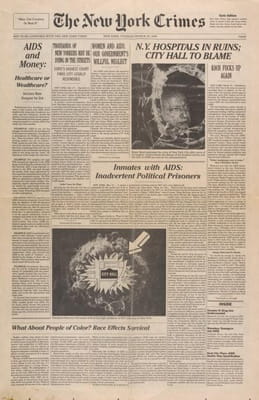
In New York in the 1980s, their work can also be understood within the context of a renewed interest among younger artists in working with mass media and imagery (which had quieted down since the rise of Pop Art in the 1960s). With a critical framework informed by writers such as Jean Beaudrillard and feminist theory, Gran Fury's peers made text-based work and Appropriation Art (framing existing images as their art). While often seen as separate to this trajectory in the New York art world, Gran Fury's work - using text, reproducing images from other sources, and engaging with advertising - put them in conversation with their more seemingly theory-driven peers.
One of the strategies the group employed which differentiated them from predecessors in activist and political art circles was to intervene at the level of distribution of media itself. The New York Crimes (1988) was a four-page broadsheet newspaper that mimicked the look and feel of The New York Times through its layout, design, and typography. The headlines and news stories, however, all highlighted issues relating to the AIDS crisis, such as "NY Hospitals in Ruins; City Hall to Blame," "AIDS and Money: Healthcare or Wealthcare?" This strategy of subverting the visual and textual codes of mainstream culture traces back to the Situationists and their method of détournement, or the re-use of existing elements in culture to create new meanings. However, Gran Fury, in fact, secretly opened newspaper boxes at night and wrapped their newspapers around the actual New York Times. Passersby and buyers who did not look closely may have mistaken them for the actual front page of The Times that day. The realization later on that this was an activist art project would also serve Gran Fury's goal, which was to create awareness of AIDS issues.
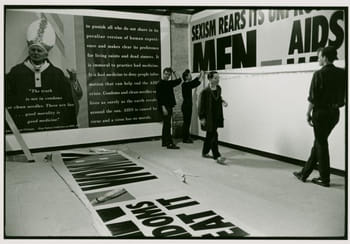
In 1990, Gran Fury were invited to participate in the prestigious Venice Biennale. The group took this opportunity to criticize the Catholic Pope's stance on homosexuality and contraception. The work for the Biennale consisted of two banners: one banner with a picture of Pope John Paul II and text directly quoting him ("The truth is not in condoms or clean needles. These are lies ... good morality is good medicine."); the second banner included a picture of an erect penis, and the command, "Men, Use Condoms or Beat It." This juxtaposition of imagery proved too much for some people, and according to group member Tom Kalin, the scandal that ensued "felt like a bomb had been dropped." The director of the Biennale, Giovanni Carandente, was outraged and threatened to resign if the work was shown. The work itself was held in Italian customs for a number of days, with authorities refusing to release such "blasphemous" work. Eventually, the piece was shown, and it received massive and global media attention. A particularly proud point for Gran Fury was that, in addition to covering the work itself, Italian newspapers were also discussing the facts of the AIDS crisis, where before they had ignored it. As Gran Fury put it, their aim all along was to "focus the press's attention away from the scandal and on to the real scandal of the AIDS crisis itself."
By the early 1990s AIDS activism had begun to slow down. This was not because the crisis was coming to an end, but rather it was due, in large part, to severe fatigue on the part of the LGBTQ activist community. So many people had been lost, and many found it difficult to keep fighting. In terms of Gran Fury's work, by 1992 there was also a good deal of public health information on AIDS available, often in the form of bus adverts, billboards, and so on. Much of this media was produced in an arresting and visually sophisticated manner, and members felt that their work in this regard was no longer necessary. By the mid-1990s, members also felt that the strategies of Gran Fury could not fully articulate the complexities and struggles of the crisis, especially with the crisis's global dimensions coming into fuller view (for example, how HIV/AIDS disproportionately affected countries with less access to healthcare resources). As member Marlene McCarty explains, "From 1988 to 1994, things changed radically. It became a whole different kind of conversation. The demographics of AIDS changed, the pharmaceuticals of AIDS changed. This is not what Gran Fury does. We decided it was time to stop." The group officially disbanded in 1995.
Gran Fury's work is now in the permanent collections of major museums with the digitized archive now available to anyone with internet access through the New York Public Library.
The Legacy of Gran Fury
A common theme in any discussion of political art has always been the question of "effectiveness" or actual impact in the real world beyond the confines of art galleries, museums, and classrooms. Seen this way, Gran Fury's legacy provides a clear (and rare) example, in the history of modern and contemporary art, of an artistic practice with an activist aim that led to tangible results. Group member Loring McAlpin, in a 2003 interview, stated: "I think what we accomplished was to drive a wedge into public discourse and open a space where AIDS could be talked about in all its dimensions. By the time we stopped, that was happening. Maybe our function was just to initiate that discussion."
Gran Fury drew the attention and admiration of activist groups and artists alike and became inspiration for later generations of artists interested in combining art and activism, especially as they intersect with questions of identity and sexuality. Their work shows that there is a way to channel anger and frustration into a powerful artistic response that resonates with who they are. McCarty reflects on the art world today and the importance precedent of Gran Fury: "Art has again become so mute in a way. It's so elite and monied and rarified. But it's really the idea that art practice can have a different kind of vibrancy around it and can speak back. That art can be active rather than passive is really important."
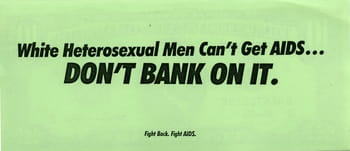
Gran Fury's media tactics, in pieces such as The New York Crimes (1988) or Wall Street Money (1987), in which they printed fake dollar bills with political messages on the back to raise awareness about pharmaceutical corporate profiteering, anticipated what cultural analysts today call "culture jamming," as scholar Marilyn Frankenstein points out. The practice entails taking over a traditional media apparatus and network for their own purpose, such as the case of the Yes Men. Outside of art, cultural commentators have remarked on the connection between ACT UP and Gran Fury's tactics to subsequent protest movements such as Occupy Wall Street.
Influences and Connections

-
![David Wojnarowicz]() David Wojnarowicz
David Wojnarowicz ![Douglas Crimp]() Douglas Crimp
Douglas Crimp- Sarah Pierce
- Gregg Bordowitz
-
![Pop Art]() Pop Art
Pop Art ![Activist Art]() Activist Art
Activist Art- Agitprop
- Poster Art
- Advertising
-
![Felix Gonzalez-Torres]() Felix Gonzalez-Torres
Felix Gonzalez-Torres -
![David Wojnarowicz]() David Wojnarowicz
David Wojnarowicz ![Yes Men]() Yes Men
Yes Men- Zoe Leonard
- Olivia Laing
 Ask The Art Story AI
Ask The Art Story AI















